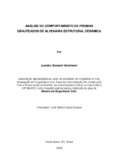| dc.creator | Grohmann, Leandro Zampieri | |
| dc.date.accessioned | 2006-11-13 | |
| dc.date.available | 2006-11-13 | |
| dc.date.issued | 2006-02-24 | |
| dc.identifier.citation | GROHMANN, Leandro Zampieri. Analysis of the behavior of grouted clay prisms for structural masonry. 2006. 160 f. Dissertação (Mestrado em Engenharia Civil) - Universidade Federal de Santa Maria, Santa Maria, 2006. | por |
| dc.identifier.uri | http://repositorio.ufsm.br/handle/1/7903 | |
| dc.description.abstract | The main purpose of this thesis is to evaluate the behavior of clay prisms
grouted, partially grouted and ungrouted under compression loads in order to
analyze the influence and performance of the grout, as well as to seek how to
optimize its applicability. For that, testing was done with different grouts and grouting
ratios.
The testing was done in 120 prisms under simple axial compression load,
where sets of prisms had two different types of mortar (A1 and A2), three different
grouts (G1, G2 e G3) and four different ratios of grouted cavities (0%, 33%, 66% e
100%). For this testing, all the materials and components were previously
characterized.
Based on experimental data, the analysis of the results was done taking into
account the different sets of prisms grouping them according to their mortar, grout
and grouting ratio. The variance analysis for the sample was done in order to prove
the existence of significant differences among the various group combinations. It was
also performed a comparison among the data found and results gathered by other
researchers.
Another investigation was done regarding the fracture behavior of prisms and
the influence of interactions among block, mortar and grout was observed.
Through the analysis of the results, some of the conclusions regarding the
behavior of prisms were: the importance of the mortar s strength for the compression
strength of the prisms; the increase in the strength of the grout does not indicate a
significant increase in the prisms strength; the significant increase in the prisms
strength is noticed only when the totality of the prisms cavities are grouted.
Overall, the use of masonry walls with partially grouted cavities is efficient if
properly used. For that, the types of grout and mortar must be suitable to and in
accordance with the mechanical behavior of the blocks used. | eng |
| dc.format | application/pdf | por |
| dc.language | por | por |
| dc.publisher | Universidade Federal de Santa Maria | por |
| dc.rights | Acesso Aberto | por |
| dc.subject | Alvenaria estrutural | por |
| dc.subject | Blocos cerâmicos e graute | por |
| dc.subject | Structural masonry | eng |
| dc.subject | Clay blocks and grout | eng |
| dc.title | Análise do comportamento de prismas
grauteados de alvenaria estrutural cerâmica | por |
| dc.title.alternative | Analysis of the behavior of grouted clay prisms
for structural masonry | eng |
| dc.type | Dissertação | por |
| dc.description.resumo | Este trabalho tem como objetivo principal avaliar o comportamento de prismas
de blocos cerâmicos grauteados, parcialmente grauteados e não-grauteados sob
a ação de cargas de compressão para que se possa analisar a influência e o
desempenho do graute e buscar sua otimização. Para tanto, foram realizados
ensaios experimentais de prismas com diferentes tipos de grautes e porcentagens
de grauteamento.
O método de pesquisa compreendeu o ensaio de compressão axial simples
de 120 prismas contrafiados de blocos cerâmicos com a utilização de dois tipos de
argamassa (A1 e A2), três tipos de grautes (G1, G2 e G3) e quatro diferentes
porcentagens de células grauteadas (0%, 33%, 66% e 100%), onde todos os
materiais e componentes empregados foram previamente caracterizados.
Com base nos dados experimentais foi realizada uma análise dos resultados
obtidos, por tipo de argamassa, tipo de graute e porcentagem de grauteamento
utilizados. Para comprovar a existência de diferenças significativas entre as várias
combinações de prismas ensaiados, foi feita a análise de variância da amostra
ensaiada. De posse destes resultados, foram feitas comparações com resultados
obtidos por outros autores.
Também observou-se, neste trabalho, os modos de ruptura dos prismas e foi
constatada a influência das interações entre bloco, argamassa e graute neste
comportamento.
Através da análise dos resultados pôde-se chegar a conclusões sobre o
comportamento dos prismas, como: a importância da resistência da argamassa na
resistência à compressão dos prismas; um aumento não significativo de resistência
dos prismas ao aumentar a resistência do graute; e um ganho efetivo de resistência
dos prismas somente ao terem a totalidade de suas células grauteadas.
De modo geral, conclui-se que a utilização do grauteamento parcial em
painéis de alvenaria é eficiente desde que seja utilizado de forma adequada,
havendo compatibilização da dosagem de traços de grautes e argamassas com as
características mecânicas dos blocos utilizados. | por |
| dc.contributor.advisor1 | Soares, José Mario Doleys | |
| dc.contributor.advisor1Lattes | http://lattes.cnpq.br/2986137592706630 | por |
| dc.contributor.referee1 | Rizzatti, Eduardo | |
| dc.contributor.referee1Lattes | http://lattes.cnpq.br/2907271596071103 | por |
| dc.contributor.referee2 | Ramires, Marcus Vinicius Veleda | |
| dc.contributor.referee2Lattes | http://lattes.cnpq.br/5038681211194894 | por |
| dc.creator.Lattes | http://lattes.cnpq.br/6362352710498004 | por |
| dc.publisher.country | BR | por |
| dc.publisher.department | Engenharia Civil | por |
| dc.publisher.initials | UFSM | por |
| dc.publisher.program | Programa de Pós-Graduação em Engenharia Civil | por |
| dc.subject.cnpq | CNPQ::ENGENHARIAS::ENGENHARIA CIVIL | por |


